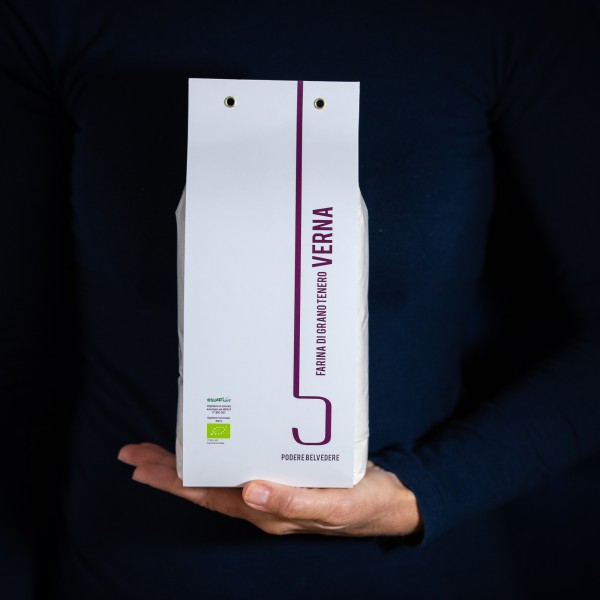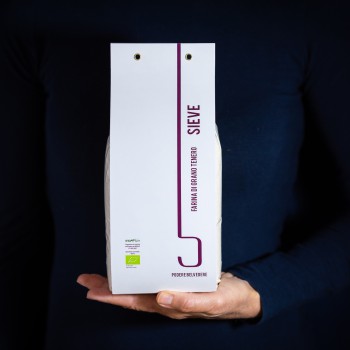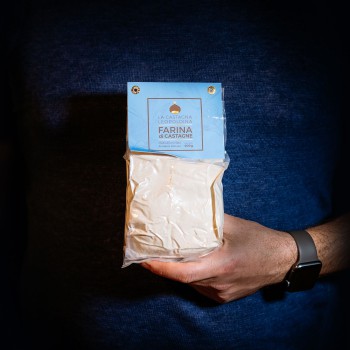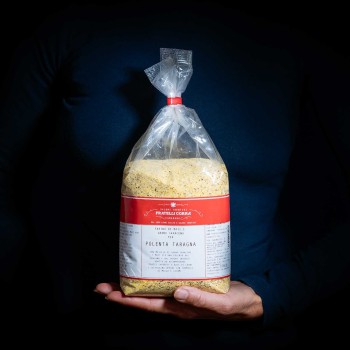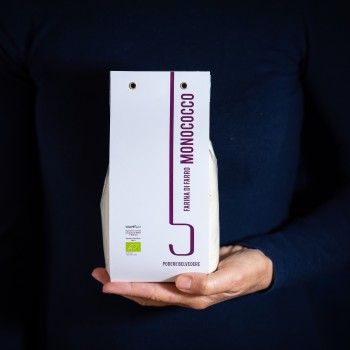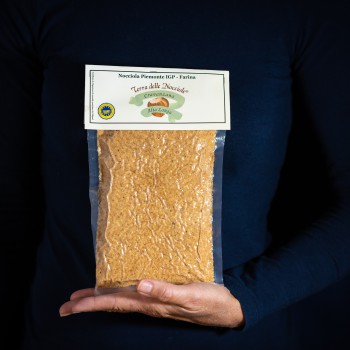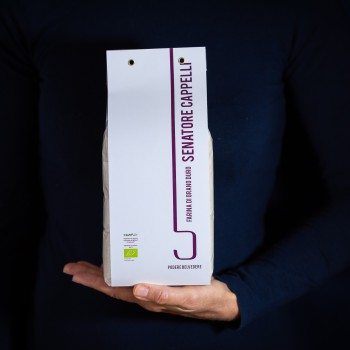Ancient Verna common wheat flour - ORGANIC - 1Kg
- Product for Vegetarians
- Product for Vegans
- Non perishable
- Lactose free
- Organic
- Would you like more info about this product? Text us on WhatsApp:+39 334 3874834
- Choose the destination country to find out prices and delivery methods
 Accepted payment methods. Secure checkout.
Accepted payment methods. Secure checkout. Verna common wheat flour was created in the 50s, as the result of crossbreeding. It is one of those Tuscan flours made from ancient wheat varieties. This common wheat is mainly cultivated in the Chiana Valley next to the city of Arezzo, but its name reveals its true origins: this wheat comes from the Verna mount in the Casentino area, where it used to be farmed by local friars.
Verna flour contains less than 1% of gluten, compared to 14% of gluten contained on average in ‘modern’ flour types.
This common wheat flour is ideal to make bread and fresh pasta!
Podere Belvedere is a farm specialised in organic farming of ancient grains. Its flours are unique and truly genuine products and are made from wheat varieties which have not been altered or modified over time.
Data sheet
- Region
- Tuscany
- Product for Vegetarians
- Yes
- Product for Vegans
- Yes
- Perishability
- Non perishable
- Lactose free
- Yes
- Organic
- Sì
Ingredients
Verna wheat flour
Allergens
Cereals containing gluten
We absolutely love Verna wheat! Verna wheat flour is much more than just a simple flour for bread making. And to think that it almost disappeared forever, despite its impressive nutrient content.
Let’s take it one step at the time! Verna wheat is a soft wheat that was patented in 1953, resulting from the cross of two wheat varieties, Est Mottin 72 and Mont Calme 245, owned by a Tuscan institution called Ente Toscano Sementi. Digging a little deeper, we found out that Ente Toscano Sementi was founded in Florence in 1929; this institution was born out of the collaboration between the Agricultural Consortium of Siena and the Agricultural University of Florence with the purpose of developing wheat production, by increasing the productive capacity of wheat varieties and extending farmland.
Where could they expand the agricultural land to, though? Perhaps to the mountains? The mountain soil was barren, mountain communities were abandoning farming practices, wheat could not withstand cold temperatures and no-one liked working at high altitude but, somehow, it all worked out.
A series of fortunate events led to the creation of a wheat variety with optimal yield and high resistance to adverse weather conditions and diseases. This wheat could be cultivated at high altitude, meaning that farmers living in mountain areas could have a new source of income.
Casentino, and especially the Verna mount, which ended up lending its name to the wheat variety, was selected for this purpose. The friars of the Franciscan Sanctuary were in charge of cultivating this exceptional wheat. This wheat variety is now widely cultivated in Valdichiana and Val d’Orcia, too, and more and more farmland is used to cultivate Verna wheat.
What about its flavour? Verna wheat flour tastes completely different than modern and “commercial” wheat varieties. It is rustic, intense and flavourful. Although it contains a low amount of gluten, it can ideally be used to make any type of dough. Here you can find some recipe ideas.
Tuscan Schiacciata flatbread with Verna wheat flour
Don’t worry, you can make Schiacciata flatbread without sour dough, too. What you need is: Verna wheat flour, brewer’s yeast, high-quality oil, coarse salt, water and a pinch of patience. You will need 7g brewer’s yeast for every 500g flour; you can just eyeball the other ingredients (sorry about that, that’s how recipes were back in the days…).
Let the yeast melt in 50ml lukewarm water, add 50g flour and knead well. Cover it and let it rise for 30 minutes. Then put the dough in a big bowl, add three tablespoons of oil, salt and the remaining flour. Knead the dough vigorously for around ten minutes, and let it rise in a warm place for one hour.
Knead it again for a couple of minutes and put it on a baking tray that was previously greased with oil. Flatten the dough and let it rest once again for 20 more minutes (for the last time!) and then bake it at 250 degrees.
This recipe is ideal to make starters, appetisers or mid-afternoon snacks. This flatbread can be paired with cheese, cold cuts, sauces, pâtés and much more.
Verna wheat Tagliatelle pasta
Only few ingredients are needed to make this incredible recipe. For every 500g Verna wheat flour, you will need 6 eggs, 2 tablespoons of oil and a pinch of salt. Verna wheat flour has a great water absorption capacity, that’s why you need to use one egg more than what you would use for traditional pasta dough.
Pile the flour into a mount on the kitchen surface and make a well in the centre, into which you break the eggs, add the oil and salt. Mix with the fork first and then knead with your hands. Form a ball, cover it with cling film and let it rest for around half an hour. Roll the dough with a rolling pin, let it dry for 10 minutes, fold it and cut the dough into Tagliatelle strips at least half a centimetre wide.
For the sauce: this pasta is so tasty that it should take the spotlight: no ragouts, mushrooms or intense cheeses. These tagliatelle pair well with squash, zucchini with flowers or a fresh tomato sauce.
Verna wheat Crostata tart
Crostata is a traditional, Italian jam-filled tart. All you need to do for this recipe is replace common wheat flour with Verna wheat flour when you make the shortcrust pastry and you will obtain a rustic, scented, genuine and delicious dessert. We suggest not rolling out the pastry too thinly, since you want to be able to taste the actual flavour of Verna wheat.
It tastes delicious with fig or blackberry jam and it is ideal for a mid-afternoon snack in the garden; fill it with a frangipane (almond custard) to make a special dessert.
Verna wheat flour is as exceptional as the wheat that is used to make it. It is ideal to make any type of dough, lending it a unique flavour. Just as there are many different types of cheese and wine, there also are different types of flour. The Verna wheat flour is nothing like cheap supermarket flour.
As is the case with many of the best traditional foodstuffs, this flour was born out of necessity. It almost disappeared once, so we should celebrate its survival by using it as much as we can. Are you ready to start rolling?






















